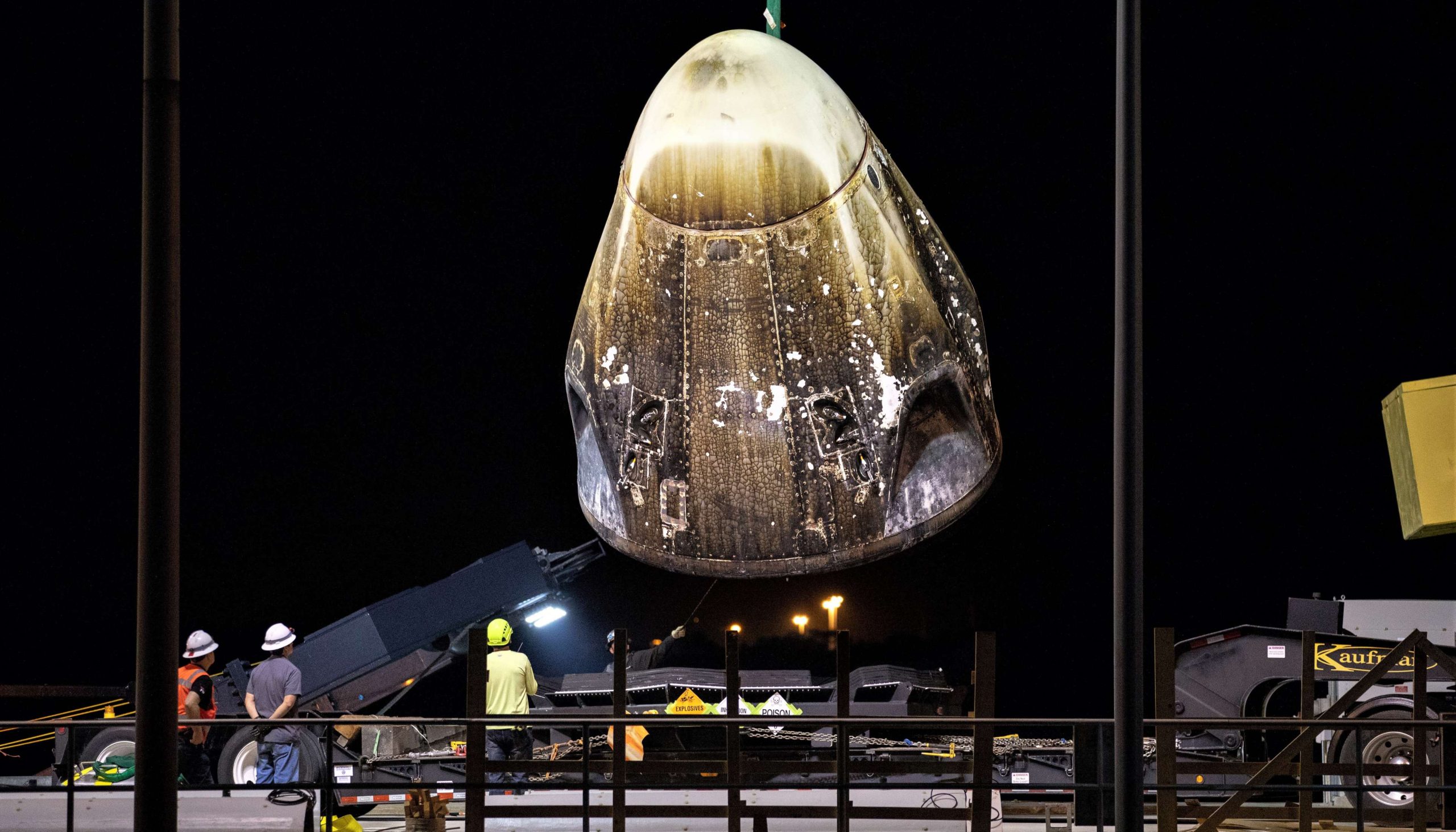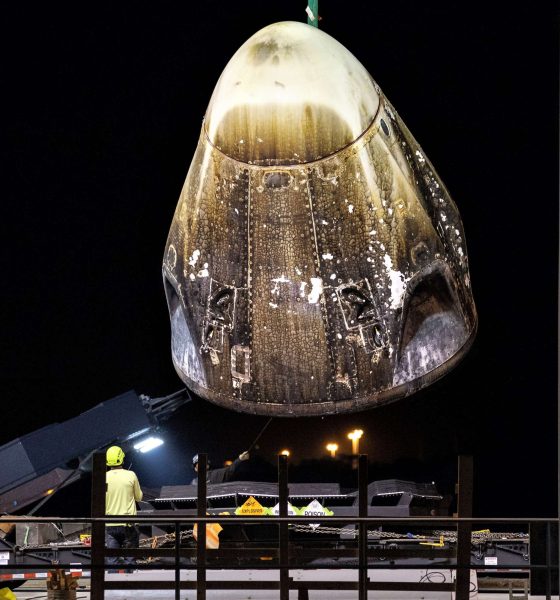

SpaceX
SpaceX CEO Elon Musk says Crew Dragon reusability a “major improvement”
SpaceX CEO Elon Musk says that the company’s next-generation Crew Dragon spacecraft is a “major improvement” over its Cargo Dragon (Dragon 1) predecessors after successfully demonstrating a number of reusability-focused upgrades during the vehicle’s launch and splashdown debut.
Even as SpaceX’s longer-term development groups aim to make the company’s Dragon spacecraft all but redundant with Starship and Super Heavy, the apparent success of Crew Dragon’s upgrades will be valuable for years to come. Ultimately, “major” improvements in reusability will allow SpaceX to reuse Dragon 2 far more efficiently, improving availability for both its Crew and Cargo programs and potentially cutting the operating cost and longevity of each spacecraft as the company begins to transition its workforce to BFR.
Although the question
As it turns out, many of the engineering solutions best known to ensure structural and thermal integrity of a spacecraft on-orbit are often at ends with the separate task of ensuring that the same spacecraft remains thoroughly water-proof through launch, reentry, and splashdown. Many of these problems center around the materials that are best for each solution. The sorts of polymers (i.e. plastics) best known for their roles in sealing certain things off from other things are frequently very pliable, soft, and flexible. The orbital environment is extremely unfriendly to polymers like this, where constant and extreme thermal cycling couples with vacuum, radiation, and something
A ‘brittle seal’, as many will know, is an oxymoron. Sealants that become brittle in space often scarcely behave like sealants at all after weeks (or months) in orbit, meaning that their ability to prevent moisture intrusion can be dramatically deteriorated. From an engineering perspective, Crew Dragon’s many seals and gaskets are first and foremost intended to protect the spacecraft from the elements while still on Earth, where static fire attempts and weather during launch windows could require it to weather extreme heat, cold, rainstorms, ice, and high winds. SpaceX engineers appear to have managed to solve the latter problem while also accounting for a need to protect the spacecraft after launch for the sake of easier refurbishment.
However, sealing the spacecraft from the elements – both before and after launch – is just one of many challenges for safe operations and efficient reusability. Up next, as Musk notes, is protecting Crew Dragon’s 16 Draco maneuvering thrusters and 8 SuperDraco abort thrusters from water damage, as well as sealing off vulnerable avionics for reuse. With respect to avionics, Musk is very likely referring to the electronics and sensing equipment housed under Dragon 2’s retractable nose cone, a new feature for SpaceX.


Due to the fact that Crew Dragon’s SuperDraco abort thrusters are only meant to be used in a namesake abort scenario, SpaceX appears to have chosen to implement a more permanent solution for protecting them from water intrusion after splashdown. The challenge of panels like those covering the SuperDracos is that they need to be easily destructible to prevent a cascade of high-velocity debris from wreaking havoc in the event of ignition. They also need to survive the conditions on orbit, make it through the heat and buffeting of reentry and
As such, it should come as no surprise to find CEO Elon Musk praising the engineering behind the presumably successful solutions to these complex problems, although credit is also due to the technicians that turned CAD files, test results, and aspirations into practical, functioning hardware.

If Crew Dragon can achieve a similar level of success after spending more like half a year in space during operational crew transport missions, the spacecraft’s reusability improvements will end up benefiting both Crew Dragon and Cargo Dragon 2. The Cargo variant of Dragon 2 is designed as a relatively minor modification to flight-proven Crew Dragon capsules and slightly-upgraded trunks and could debut as early as mid-2020 after Cargo Dragon 1 enters retirement.
Check out Teslarati’s Marketplace! We offer Tesla accessories, including for the Tesla Cybertruck and Tesla Model 3.

Elon Musk
Starlink passes 9 million active customers just weeks after hitting 8 million
The milestone highlights the accelerating growth of Starlink, which has now been adding over 20,000 new users per day.

SpaceX’s Starlink satellite internet service has continued its rapid global expansion, surpassing 9 million active customers just weeks after crossing the 8 million mark.
The milestone highlights the accelerating growth of Starlink, which has now been adding over 20,000 new users per day.
9 million customers
In a post on X, SpaceX stated that Starlink now serves over 9 million active users across 155 countries, territories, and markets. The company reached 8 million customers in early November, meaning it added roughly 1 million subscribers in under seven weeks, or about 21,275 new users on average per day.
“Starlink is connecting more than 9M active customers with high-speed internet across 155 countries, territories, and many other markets,” Starlink wrote in a post on its official X account. SpaceX President Gwynne Shotwell also celebrated the milestone on X. “A huge thank you to all of our customers and congrats to the Starlink team for such an incredible product,” she wrote.
That growth rate reflects both rising demand for broadband in underserved regions and Starlink’s expanding satellite constellation, which now includes more than 9,000 low-Earth-orbit satellites designed to deliver high-speed, low-latency internet worldwide.
Starlink’s momentum
Starlink’s momentum has been building up. SpaceX reported 4.6 million Starlink customers in December 2024, followed by 7 million by August 2025, and 8 million customers in November. Independent data also suggests Starlink usage is rising sharply, with Cloudflare reporting that global web traffic from Starlink users more than doubled in 2025, as noted in an Insider report.
Starlink’s momentum is increasingly tied to SpaceX’s broader financial outlook. Elon Musk has said the satellite network is “by far” the company’s largest revenue driver, and reports suggest SpaceX may be positioning itself for an initial public offering as soon as next year, with valuations estimated as high as $1.5 trillion. Musk has also suggested in the past that Starlink could have its own IPO in the future.
News
SpaceX shades airline for seeking contract with Amazon’s Starlink rival

SpaceX employees, including its CEO Elon Musk, shaded American Airlines on social media this past weekend due to the company’s reported talks with Amazon’s Starlink rival, Leo.
Starlink has been adopted by several airlines, including United Airlines, Qatar Airways, Hawaiian Airlines, WestJet, Air France, airBaltic, and others. It has gained notoriety as an extremely solid, dependable, and reliable option for airline travel, as traditional options frequently cause users to lose connection to the internet.
Many airlines have made the switch, while others continue to mull the options available to them. American Airlines is one of them.
A report from Bloomberg indicates the airline is thinking of going with a Starlink rival owned by Amazon, called Leo. It was previously referred to as Project Kuiper.
American CEO Robert Isom said (via Bloomberg):
“While there’s Starlink, there are other low-Earth-orbit satellite opportunities that we can look at. We’re making sure that American is going to have what our customers need.”
Isom also said American has been in touch with Amazon about installing Leo on its aircraft, but he would not reveal the status of any discussions with the company.
The report caught the attention of Michael Nicolls, the Vice President of Starlink Engineering at SpaceX, who said:
“Only fly on airlines with good connectivity… and only one source of good connectivity at the moment…”
CEO Elon Musk replied to Nicolls by stating that American Airlines risks losing “a lot of customers if their connectivity solution fails.”
American Airlines will lose a lot of customers if their connectivity solution fails
— Elon Musk (@elonmusk) December 14, 2025
There are over 8,000 Starlink satellites in orbit currently, offering internet coverage in over 150 countries and territories globally. SpaceX expands its array of satellites nearly every week with launches from California and Florida, aiming to offer internet access to everyone across the globe.
Currently, the company is focusing on expanding into new markets, such as Africa and Asia.
News
Tesla hints at Starlink integration with recent patent
“By employing polymer blends, some examples enable RF transmission from all the modules to satellites and other communication devices both inside and outside the vehicle.”

Tesla hinted at a potential Starlink internet terminal integration within its vehicles in a recent patent, which describes a vehicle roof assembly with integrated radio frequency (RF) transparency.
The patent, which is Pub. No U.S. 2025/0368267 describes a new vehicle roof that is made of RF-transparent polymer materials, allowing and “facilitating clear communication with external devices and satellites.”
Tesla believes that a new vehicle roof design, comprised of different materials than the standard metallic or glass elements used in cars today, would allow the company to integrate modern vehicular technologies, “particularly those requiring radio frequency transmission and reception.
Tesla has recently filed a US patent application on integrating RF transparent materials into the roof structure.
“facilitating clear communication with external devices and satellites”
Tesla fleet is getting @Starlink connectivity integration soon. LFG @Tesla @elonmusk… pic.twitter.com/bLa8YtPLd1
— Chansoo Byeon (@Chansoo) December 9, 2025
Instead of glass or metallic materials, Tesla says vehicles may benefit from high-strength polymer blends, such as Polycarbonate, Acrylonitrile Butadiene Styrene, or Acrylonitrile Styrene Acrylate.
These materials still provide ideal strength metrics for crashworthiness, stiffness for noise, vibration, and harshness control, and are compliant with head impact regulations.
They would also enable better performance with modern technologies, like internet terminals, which need an uninterrupted signal to satellites for maximum reception. Tesla writes in the patent:
“By employing polymer blends, some examples enable RF transmission from all the modules to satellites and other communication devices both inside and outside the vehicle.”

One of the challenges Tesla seems to be aware of with this type of roof design is the fact that it will still have to enable safety and keep that at the forefront of the design. As you can see in the illustration above, Tesla plans to use four layers to increase safety and rigidity, while also combating noise and vibration.
It notes in the patent that disclosed examples still meet the safety requirements outlined in the Federal Motor Vehicle Safety Standards (FMVSS).
Starlink integrated directly into Tesla vehicles would be a considerable advantage for owners. It would come with a handful of distinct advantages.
Initially, the inclusion of Starlink would completely eliminate cellular dead zones, something that is an issue, especially in rural areas. Starlink would provide connectivity in these remote regions and would ensure uninterrupted service during road trips and off-grid adventures.
It could also be a critical addition for Robotaxi, as it is crucial to have solid and reliable connectivity for remote monitoring and fleet management.
Starlink’s growing constellation, thanks to SpaceX’s routine and frequent launch schedule, will provide secure, stable, and reliable internet connectivity for Tesla vehicles.
Although many owners have already mounted Starlink Mini dishes under their glass roofs for a similar experience, it may be integrated directly into Teslas in the coming years, either as an upgrade or a standard feature.








